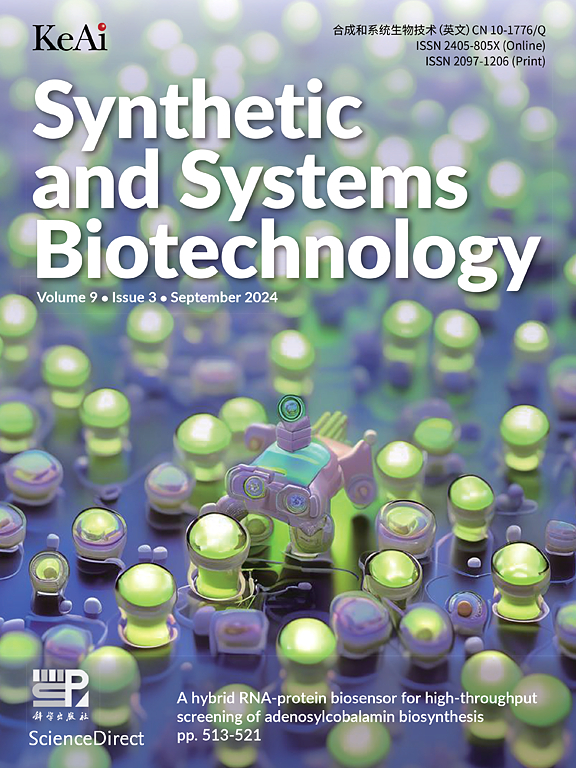微生物紫红质产生的质子动力促进细胞外电子转移。
IF 4.4
2区 生物学
Q1 BIOTECHNOLOGY & APPLIED MICROBIOLOGY
引用次数: 0
摘要
电活性微生物在生物电化学系统中实用性的主要限制在于其低细胞外电子转移(EET)效率。质子动势(proton motive force, PMF)代表了质子在细胞质膜上的电子传递和质子泵送所产生的电化学梯度,是细菌膜中重要的能量传递途径。然而,PMF对EET效率的影响尚不明确,而微生物视紫红质为非光合细胞利用PMF提供了一种简单有效的途径。在此,我们研究了三种微生物视紫红质(Arch, Mac和cR-1)在电活性微生物S. oneidensis中的异源表达促进EET的功能。其中,表达rhodopsin cR-1的重组菌株的输出功率密度最高,为0.87 W/m2,是野生型s.o idensis MR-1的3.49倍。我们进一步对菌株cR-1的能量和物质代谢的转录组学分析表明,EET效率提高的潜在机制是由光驱动质子泵的异源表达引起的。结果表明,菌株cR-1有效地排出质子,产生额外的PMF,并为细胞提供额外的ATP供应,促进了乳酸的吸收和利用,从而增强了细胞内电子的产生。细胞内电子池容量的增加最终提高了重组棘球蚴的EET率和发电效率。本文章由计算机程序翻译,如有差异,请以英文原文为准。
Proton motive force generated by microbial rhodopsin promotes extracellular electron transfer
The primary limitation to the practicability of electroactive microorganisms in bioelectrochemical systems lies in their low extracellular electron transfer (EET) efficiency. The proton motive force (PMF) represents the electrochemical gradient of protons generated by electron transport and proton pumping across the cytoplasmic membrane, serving as a crucial energy transfer pathway in bacterial membranes. Nevertheless, the impact of PMF on the EET efficiency remains ambiguous, while the microbial rhodopsin offers a simple and efficient avenue for non-photosynthetic cells to harness PMF. Here, we studied the function of three microbial rhodopsins (Arch, Mac, and cR-1) in facilitating EET via their heterologous expression in S. oneidensis, a model electroactive microorganism. Among these, the recombinant strain expressing rhodopsin cR-1 exhibited the highest output power density of 0.87 W/m2, 3.49-fold increase over the wild-type S. oneidensis MR-1. Our further transcriptomics analyses of the energy and materials metabolism of strain cR-1 showed that the underlying mechanism of enhanced EET efficiency was resulted from heterologous expression of the light-driven proton pump. The results suggested that strain cR-1 effectively expels protons to generate additional PMF and provide extra ATP supply to the cells, which facilitated lactate uptake and utilization, thus enhancing electrons generation in cells. This augmented intracellular electron pool capacity ultimately resulted in enhancement of EET rate and power generation efficiency of the recombinant S. oneidensis.
求助全文
通过发布文献求助,成功后即可免费获取论文全文。
去求助
来源期刊

Synthetic and Systems Biotechnology
BIOTECHNOLOGY & APPLIED MICROBIOLOGY-
CiteScore
6.90
自引率
12.50%
发文量
90
审稿时长
67 days
期刊介绍:
Synthetic and Systems Biotechnology aims to promote the communication of original research in synthetic and systems biology, with strong emphasis on applications towards biotechnology. This journal is a quarterly peer-reviewed journal led by Editor-in-Chief Lixin Zhang. The journal publishes high-quality research; focusing on integrative approaches to enable the understanding and design of biological systems, and research to develop the application of systems and synthetic biology to natural systems. This journal will publish Articles, Short notes, Methods, Mini Reviews, Commentary and Conference reviews.
 求助内容:
求助内容: 应助结果提醒方式:
应助结果提醒方式:


